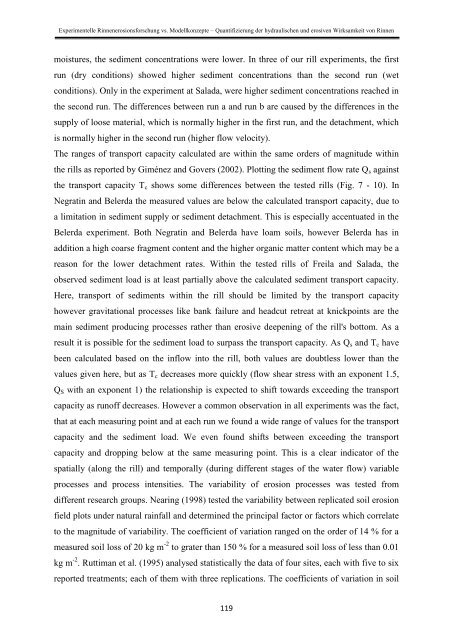Stefan Wirtz Vom Fachbereich VI (Geographie/Geowissenschaften ...
Stefan Wirtz Vom Fachbereich VI (Geographie/Geowissenschaften ...
Stefan Wirtz Vom Fachbereich VI (Geographie/Geowissenschaften ...
You also want an ePaper? Increase the reach of your titles
YUMPU automatically turns print PDFs into web optimized ePapers that Google loves.
Experimentelle Rinnenerosionsforschung vs. Modellkonzepte – Quantifizierung der hydraulischen und erosiven Wirksamkeit von Rinnen<br />
moistures, the sediment concentrations were lower. In three of our rill experiments, the first<br />
run (dry conditions) showed higher sediment concentrations than the second run (wet<br />
conditions). Only in the experiment at Salada, were higher sediment concentrations reached in<br />
the second run. The differences between run a and run b are caused by the differences in the<br />
supply of loose material, which is normally higher in the first run, and the detachment, which<br />
is normally higher in the second run (higher flow velocity).<br />
The ranges of transport capacity calculated are within the same orders of magnitude within<br />
the rills as reported by Giménez and Govers (2002). Plotting the sediment flow rate Q s against<br />
the transport capacity T c shows some differences between the tested rills (Fig. 7 - 10). In<br />
Negratin and Belerda the measured values are below the calculated transport capacity, due to<br />
a limitation in sediment supply or sediment detachment. This is especially accentuated in the<br />
Belerda experiment. Both Negratin and Belerda have loam soils, however Belerda has in<br />
addition a high coarse fragment content and the higher organic matter content which may be a<br />
reason for the lower detachment rates. Within the tested rills of Freila and Salada, the<br />
observed sediment load is at least partially above the calculated sediment transport capacity.<br />
Here, transport of sediments within the rill should be limited by the transport capacity<br />
however gravitational processes like bank failure and headcut retreat at knickpoints are the<br />
main sediment producing processes rather than erosive deepening of the rill's bottom. As a<br />
result it is possible for the sediment load to surpass the transport capacity. As Q s and T c have<br />
been calculated based on the inflow into the rill, both values are doubtless lower than the<br />
values given here, but as T c decreases more quickly (flow shear stress with an exponent 1.5,<br />
Q S with an exponent 1) the relationship is expected to shift towards exceeding the transport<br />
capacity as runoff decreases. However a common observation in all experiments was the fact,<br />
that at each measuring point and at each run we found a wide range of values for the transport<br />
capacity and the sediment load. We even found shifts between exceeding the transport<br />
capacity and dropping below at the same measuring point. This is a clear indicator of the<br />
spatially (along the rill) and temporally (during different stages of the water flow) variable<br />
processes and process intensities. The variability of erosion processes was tested from<br />
different research groups. Nearing (1998) tested the variability between replicated soil erosion<br />
field plots under natural rainfall and determined the principal factor or factors which correlate<br />
to the magnitude of variability. The coefficient of variation ranged on the order of 14 % for a<br />
measured soil loss of 20 kg m -2 to grater than 150 % for a measured soil loss of less than 0.01<br />
kg m -2 . Ruttiman et al. (1995) analysed statistically the data of four sites, each with five to six<br />
reported treatments; each of them with three replications. The coefficients of variation in soil<br />
119
















